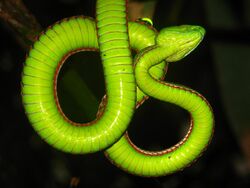Biology:Trimeresurus medoensis
| Trimeresurus medoensis | |
|---|---|

| |
| Scientific classification | |
| Domain: | Eukaryota |
| Kingdom: | Animalia |
| Phylum: | Chordata |
| Class: | Reptilia |
| Order: | Squamata |
| Suborder: | Serpentes |
| Family: | Viperidae |
| Genus: | Trimeresurus |
| Species: | T. medoensis
|
| Binomial name | |
| Trimeresurus medoensis Zhao, 1977
| |
| Synonyms | |
Trimeresurus medoensis, commonly named the Motuo bamboo pitviper,[4] is a venomous pitviper species endemic to India , Burma, and Tibet. No subspecies are currently recognized.[5]
Description
Maximum total length for males is 671 mm (26.4 in); for females, 650 mm (26 in). Maximum tail length for males is 125 mm (4.9 in); for females, 115 mm (4.5 in).[6]
The hemipenes are short, thick, and spinose.[6]
Scalation: dorsal scales in 17 longitudinal rows at midbody, of which rows 7-11 are slightly keeled. There are 8 upper labials, of which the first are separated from the nasal scales by a distinct suture. The ventrals number less than 150.[6]
Color pattern: green or bluish green above, yellowish white below, the two separated by a bright bicolored red (below) and white (above) ventrolateral stripe (in both males and females), which occupies the whole of the outermost scale row and a portion of the second row.[6]
Geographic range
Found in North-Eastern India ; northern Burma (Myanmar); and southeastern Xizang (Tibet), China . The type locality listed is "near A-ni Bridge, Medo Xian, Xizang [Tibet], alt. 1,200 m [3,900 ft]" [Autonomous Region, China].[2]
References
- ↑ Zhou, Z.; Rao, D.-q. (2012). "Viridovipera medoensis". The IUCN Red List of Threatened Species (IUCN) 2012: e.T192090A2038504. doi:10.2305/IUCN.UK.2012-1.RLTS.T192090A2038504.en. http://www.iucnredlist.org/details/192090/0. Retrieved 15 January 2018.
- ↑ 2.0 2.1 McDiarmid RW, Campbell JA, Touré T. 1999. Snake Species of the World: A Taxonomic and Geographic Reference, Volume 1. Herpetologists' League. 511 pp. ISBN:1-893777-00-6 (series). ISBN:1-893777-01-4 (volume).
- ↑ The Reptile Database. www.reptile-database.org.
- ↑ Gumprecht A, Tillack F, Orlov NL, Captain A, Ryabov S. 2004. Asian Pitvipers. Geitje Books. Berlin. 1st Edition. 368 pp. ISBN:3-937975-00-4.
- ↑ "Trimeresurus medoensis". Integrated Taxonomic Information System. https://www.itis.gov/servlet/SingleRpt/SingleRpt?search_topic=TSN&search_value=634925. Retrieved 25 May 2007.
- ↑ 6.0 6.1 6.2 6.3 Leviton AE, Wogan GOU, Koo MS, Zug GR, Lucas RS, Vindum JV. 2003. The Dangerously Venomous Snakes of Burma, Illustrated Checklist with Keys. Proc. Cal. Acad. Sci. 54 (24): 407-462.
Further reading
- David, Patrick; and Tong, Haiyan. 1997. Translations of Recent Descriptions of Chinese Pitvipers of the Trimeresurus-Complex (Serpentes, Viperidae), with a Key to the Complex in China and Adjacent Areas. Smithsonian Herpetological Information Service (112): 1-31.
- David, Patrick; Ashok Captain; and Bharat B. Bhatt. 2002 [2001]. On the occurrence of Trimeresurus medoensis Djao in: Djao & Jaing, 1977 (Serpentes, Viperidae, Crotalinae) in India, with a redescription of the species and notes on its biology. Hamadryad 26 (2): 210-226.
- Djao, Er-mie; and Jiang, Yao-ming. 1977. A survey of reptiles in Xizang Autonomous Region, with faunal analysis and descriptions of new forms. Acta Zoologica Sinica 23: 64-67.
External links
- Trimeresurus medoensis at the Reptarium.cz Reptile Database. Accessed 4 December 2012.
Wikidata ☰ Q1037349 entry
 |



